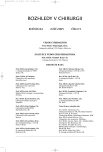A Contemporary Situation in the Antimicrobial Treatment of the Secondary Peritonitis
Authors:
F. Vyhnánek; J. Vranková
Authors‘ workplace:
Mikrobiologický ústav 3. LF UK Praha, přednosta doc. MUDr. M. Bednář, CSc.
; Chirurgická klinika 3. LF UK Praha, přednosta doc. MUDr. J. Fanta, DrSc.
Published in:
Rozhl. Chir., 2005, roč. 84, č. 9, s. 466-471.
Category:
Monothematic special - Original
Overview
Peritonitis infection is polymicrobial, with the following prevailing pathogens – gram-negative aerobic and anaerobic bacteria and anaerobic cocci. Treatment of the secondary peritonitides includes surgical management of the infectious focus, initial empiric antimicrobial therapy and intensive adjunctive therapy aimed to control any secondary and terciary disorders.
Materials, Methods and Results:
Based on the results of the actual sensitivity of each pathogen of the intraabdominal infections and on the results of the past restrospective clinical studies, recommendations for initial empiric antimicrobial therapy of the secondary peritonitis have been compiled. Sensitivity of aerobic pathogens to parenterally administered antibiotics in the secondary peritonitits was regulary recorded and the results were summarized in 2004. The minimum inhibition concentrations (MIC in mg/l for the anaerobic bacteria and cocci are presented, based on present data of the National Reference Laboratory for Anaerobic Bacteria. A comparative retrospective study of the antimicrobial treatment in the secondary peritonitis from perforation of the diverticle of the large intestine, proved comparable results between treatment with antimicrobial monotherapy (piperacillin/tazobactam) and combined therapy (aminoglycosides with lincosamides or with nitroimidasoles). The effect of antimicrobial prophylaxis and therapy (aminopenicillines with the beta-lactamase inhibitor) was assessed in another restrospective study in acute appendicitis. The recommendations for initial empiric antimicrobial therapy in the secondary peritonitis are based on clinical and peroperative findings, on an estimated prevalence of the pathogens in the infectious focus and on sensitivity results of the individual antimicrobial medicines to the commonest pathogens in the secondary peritonitis.
Results:
1. Initial empiric antimicrobial treatment in the secondary peritonitis as a monotherapy with a broad-spectrum antibiotic or a combination of two antibiotics, should be effective against gram-negative aerobic, anaerobic bacteria and cocci. 2. With respect to morbidity and mortality rates, related to enterococcus infection not affected by antimicrobial therapy, administration of an antibiotic effective against enterococci is justified. 3. The choice of an antibiotic, duration and method of administration is based on the diagnosed infectious focus, peritonitis stage, on the current sensitivity findings of the commonest pathogens and on the overall condition of the patient (underlying disorders, immunodeficiency). 4. Treatment of other pathogens – Pseudomonas aeruginosa and mycoses is based on their laboratory confirmation and their sensitivity examination and usually is not an essential part of the initial empiric treatment. 5. In the initial empiric treatmet of early stages of the peritonitis, aminopenicilllin with the beta-lactamase inhibitor is the antibiotic of choice. 6. Due to its broad-spectrum effect against isolated bacteria and the safety parameters and low toxicity when used as monotherapy, pipracillin/tazobactam is indicated as the antibiotic of choice in advanced peritonitides with underlying disorders of the aboral part of the digestive tract.
Key words:
secondary peritonitis – antimicrobial treatment – monotherapy – combined treatment
Labels
Surgery Orthopaedics Trauma surgeryArticle was published in
Perspectives in Surgery

2005 Issue 9
Most read in this issue
- Comments on Eversion Technique of Carotid Endarterectomy
- The Liver Splenosis in a Patient Following a Procedure for the Malignant Seminoma
- Duodenal Stump Closure – Still a Live Problem. A Case Report
- A Contemporary Situation in the Antimicrobial Treatment of the Secondary Peritonitis
